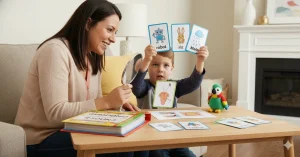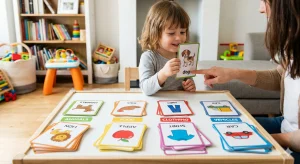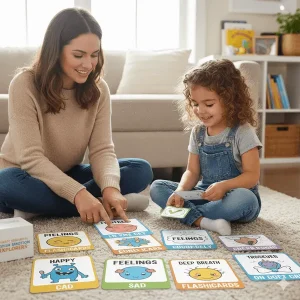8 Fun Spring Activities for Kids with Autism
By Rajini D
Last Updated: September 25, 2024
As the weather warms up and spring comes into full bloom, it’s the perfect time to get outside and enjoy some fun activities with your child. Spring offers endless opportunities for kids with autism to engage in outdoor play, helping them connect with nature while developing important skills. Whether it’s through sensory experiences or physical activities, spring is a wonderful season to explore new ways of learning and growing.
Also read: 8 Engaging Sensory Exercises for Kids with Autism
Children with autism often benefit greatly from activities that cater to their unique sensory and motor needs. Simple adjustments, like choosing quieter times for outings or creating a calming environment, can make outdoor play more accessible and enjoyable. From obstacle courses to sensory bins, there are plenty of spring activities for kids with autism that can be tailored to fit your child’s preferences.
1. Create an Obstacle Course in Your Backyard
Creating an obstacle course is one of the most engaging outdoor activities for children with autism. It’s a great way to encourage movement, build motor skills, and have fun at the same time. The best part?
You don’t need any fancy equipment—simple household items like stepping stones, ropes, chairs, or even pool noodles can do the trick!
Read More: Oral motor Exercises: Key to Better Speech
Designing an obstacle course allows children to work on their coordination and balance, whether they are stepping over objects, crawling under tables, or navigating through a maze of cones. It’s not just about physical activity; it also helps them develop important cognitive skills like problem-solving and planning. You can even turn it into one of the most fun spring games for autistic kids by allowing them to take the lead and design parts of the course themselves. This not only boosts creativity but also promotes independence and confidence.
2. Visit the Playground During Off-Peak Hours
For children with autism, large crowds and noisy environments can feel overwhelming. Visiting the playground during quieter, off-peak hours can turn a stressful outing into a more enjoyable experience. Early mornings or weekdays are typically less busy, giving your child the space to explore at their own pace.
A less crowded playground provides a calm environment, allowing kids to enjoy swings, slides, and other equipment without feeling rushed. This also gives you the chance to engage closely with your child, helping them with activities that reinforce social and motor skills.
Before you go, visit the playground to see if it suits your child’s needs. Some playgrounds feature sensory-friendly designs, like quieter zones, accessible equipment, or soft surfaces, making them ideal for children with autism. You can include this in your spring break ideas, combining outdoor fun with sensory play.
3. Go on a Nature Treasure Hunt
Going on a nature treasure hunt is a fun and simple way to combine physical activity with sensory engagement for your child. A walk on a nature trail, or even in your neighborhood, can turn into an adventure full of discovery. As one of the most engaging spring sensory activities for autistic kids, this activity allows children to explore their surroundings while developing their motor skills and fine-tuning their senses.
Slow down the pace and let your child take the lead. Encourage them to notice the small details that are often overlooked—leaves, rocks, flowers, or even birds. You can create a simple checklist of things to find, or let the adventure unfold naturally. The key is to make it an interactive and enjoyable experience for your child, giving them the freedom to explore and learn in their own way.
4. Enjoy Aqua Therapy Play in the Backyard
Warm spring days are perfect for water-based sensory play! A sensory bin filled with water beads, marbles, or water-safe toys can offer a calming and therapeutic experience for kids with autism. Water play helps children regulate their senses and provides an enjoyable way to explore different textures and sensations. This makes it one of the top sensory play for kids with autism ideas to try out in your backyard.
To set up a simple sensory bin, you can use items like water beads, plastic animals, marbles, and small bath toys. You can also add a bit of color to the water with food coloring or make bubbles for an extra layer of sensory excitement. This activity encourages hands-on exploration while promoting sensory processing, making it an ideal choice for autism-friendly spring ideas.
5. Set Up Sensory Bins Outdoors
Sensory bins are a fantastic way for children with autism to engage in hands-on, tactile exploration. And by setting them up outdoors, you can minimize the mess while maximizing the fun! Engaging springtime activities for children with autism like sensory play are perfect for boosting fine motor skills and helping children explore different textures, shapes, and materials.
To create a sensory bin, you can use everyday items such as beans, rice, sand, or even pasta. The key is to pick materials that offer a variety of sensory experiences. For example, you could fill one bin with soft sand and another with smooth pebbles or buttons. Encourage your child to dig, scoop, and feel these different textures, which helps to develop their fine motor skills and enhance sensory development.
Another great idea is to adapt sensory bins based on your child’s specific interests and needs. For instance, if your child enjoys water, you can include water-safe items or mix different textures to create a rich sensory experience. You can also incorporate seasonal items like flowers or leaves for a spring-themed sensory bin.
6. Chalk Art on Sidewalks or Patios
Sidewalk chalk art is a fun way for kids with autism to express themselves while improving fine motor skills. It’s a simple and effective spring sensory activity that combines creativity, sensory play, and physical development. Drawing with chalk allows children to explore shapes, patterns, and colors in an outdoor space.
Parents can encourage their kids to draw favorite characters, animals, or nature scenes. This activity fosters imagination and helps with hand-eye coordination and grip strength. For children with sensory sensitivities, thicker chalk or chalk holders can make the experience more comfortable.
Choose a patio, driveway, or sidewalk, giving kids space to create large, colorful drawings. This makes it a fun and easy spring activity for autistic children to enjoy. From rainbows to shapes, the possibilities are endless!
7. Garden Together
Gardening can be a wonderfully therapeutic and educational activity for children with autism. It offers a unique opportunity to connect with nature while promoting important life skills like patience, responsibility, and sensory engagement. Simple tasks such as planting seeds, watering plants, and watching them grow over time provide a hands-on way for children to learn about the world around them. It’s one of the most fulfilling outdoor activities for children with autism because it encourages both sensory and motor skill development.
Gardening involves sensory stimulation through touch and smell, making it an engaging and calming experience for kids. Handling soil, feeling different textures of plants, and even the smell of fresh flowers or herbs can provide a rich sensory environment. This natural sensory exposure can have a calming effect on children, helping them focus and relax in a peaceful outdoor setting.
Parents can start small by planting easy-to-grow seeds in a garden bed or pots. Let your child take the lead—whether it’s watering the plants or deciding where to place them in the garden. Watching the plants grow can teach patience and the reward of nurturing life, making it one of the most meaningful spring break ideas for kids with autism.
8. Fly a Kite on a Breezy Day
Flying a kite is a simple and joyful outdoor activity for kids with autism. It helps improve hand-eye coordination as they manage the kite string and control its movements. Watching the kite soar provides visual stimulation and can have a calming, soothing effect.
Parents should choose open spaces with minimal distractions, like a large field or quiet beach. This allows your child to focus on the kite without feeling overwhelmed. Keeping the experience simple and relaxed lets your child engage at their own pace. Flying a kite is a perfect blend of outdoor fun and sensory engagement.
Autism-Friendly Spring Activities for kids at a Glance
| Activity | Sensory Benefits | Motor Skill Development | Social Interaction |
|---|---|---|---|
| Obstacle Course | Tactile, balance, coordination | Builds agility | Limited social exposure |
| Visit Playground | Outdoor sensory experience | Climbing, sliding | Interaction with peers |
| Nature Treasure Hunt | Visual and tactile exploration | Walking, climbing | Parent-child interaction |
| Aqua Therapy Play | Water-based sensory processing | Hand coordination | Parent-child interaction |
| Sensory Bins Outdoors | Tactile (beans, sand, rice) | Fine motor skills | None |
| Chalk Art | Visual and tactile stimulation | Hand-eye coordination | Parent-child interaction |
| Gardening Together | Touch and smell (soil, plants) | Hand coordination, patience | None |
| Fly a Kite | Visual tracking, touch (string) | Hand-eye coordination | Parent-child interaction |
Also read: 8 Engaging Sensory Exercises for Kids with Autism
Conclusion
Outdoor activities during springtime offer many benefits for children with autism. They help kids develop important motor skills, enjoy sensory play, and interact with others in a safe, comfortable setting. Simple activities like flying a kite, gardening, or creating an obstacle course can be both fun and educational, allowing children to explore and learn at their own pace.
At Wellness Hub, we know how important it is to create activities that help children thrive. If you’re looking for more ideas, resources, or therapy options that are tailored to your child’s needs, feel free to explore what we offer at WellnessHub. We’re here to support your child’s growth and development in ways that work best for them.
Frequently Asked Questions:
1. What are some fun spring activities for kids with autism?
There are many enjoyable spring activities for kids with autism, such as flying a kite, creating a backyard obstacle course, gardening, and sidewalk chalk art. These activities help with sensory engagement, motor skill development, and outdoor exploration.
2. How can outdoor activities benefit kids with autism?
Outdoor activities provide children with autism opportunities to improve their sensory processing, motor skills, and social interaction. Activities like nature walks or sensory play with water and sand are calming and help kids engage with their surroundings.
3. What are some autism-friendly outdoor activities for spring?
Autism-friendly activities for spring include gardening, water play, treasure hunts, and chalk art. These activities are adaptable and provide a calm, structured environment for children to explore and enjoy.
4. How can I create an obstacle course for my child with autism?
You can create a simple obstacle course using household items like ropes, chairs, and stepping stones. This helps build motor skills and encourages creativity. It’s a fun and engaging way for kids with autism to enjoy outdoor play.
5. How does sensory play benefit children with autism?
Sensory play, such as using sensory bins with water, rice, or beans, helps children with autism explore different textures and sensations. It supports fine motor skill development and provides a calming experience.
6. Why is flying a kite a good activity for kids with autism?
Flying a kite helps improve hand-eye coordination and provides a soothing sensory experience as children watch the kite move through the sky. It’s a simple, enjoyable outdoor activity that can be done in a quiet, open space.
7. How can I make outdoor activities more enjoyable for my child with autism?
To make outdoor activities more enjoyable, choose quiet locations, bring familiar items, and allow your child to explore at their own pace. Activities like gardening and nature treasure hunts can be tailored to your child’s interests and sensory needs.
8. What are some easy sensory activities for kids with autism during spring?
Easy sensory activities for spring include sensory bins with water beads, sidewalk chalk art, and playing with sand or pebbles. These activities provide hands-on exploration while supporting sensory development.
9. How can gardening help children with autism?
Gardening is a therapeutic and educational activity that helps children with autism develop patience, responsibility, and sensory engagement. Activities like planting seeds and watering plants offer a hands-on way for children to connect with nature while improving motor skills and sensory processing.
10. What are some simple spring break ideas for kids with autism?
Simple spring break ideas for kids with autism include going on nature treasure hunts, visiting the playground during quieter times, and enjoying sensory activities like water play or chalk art. These activities provide a calm, engaging way for children to have fun while developing important skills.
About the Author:
Rajini Darugupally
M.Sc., Speech-Language Pathologist (9+ years of experience)
Rajini is a passionate and dedicated Speech-Language Pathologist with over 9+ years of experience, specializing in both developmental speech and language disorders in children and rehabilitation in adults. Driven by a desire to empower each individual to find their voice, Rajini brings a wealth of experience and a warm, genuine approach to therapy. Currently, at Wellness Hub, she thrives in a team environment that values innovation, compassion, and achieving results for their clients.
Book your Free Consultation Today
Parent/Caregiver Info:
Client’s Details:
* Error Message









